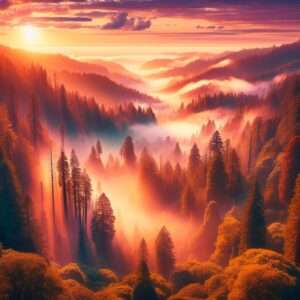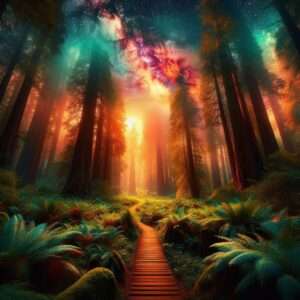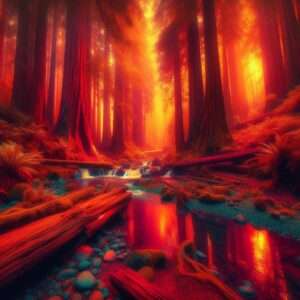Exploring Redwood National and State Parks: 7 Must-See Wonders in Northern California
Introduction
Welcome to the enchanting realm of Redwood National and State Parks, where nature unfolds its grandeur in the form of towering giants and pristine coastal landscapes. Picture yourself surrounded by ancient redwoods, their colossal trunks reaching skyward, creating a canopy that dances with the sunlight. As you embark on this virtual journey, prepare to be captivated by the symphony of nature – from the rustling leaves of the majestic trees to the rhythmic melody of the Pacific waves.
In this blog, we invite you to join us on an exploration of a place where time seems to stand still, and the wonders of the natural world take center stage. Whether you’re a seasoned nature enthusiast or someone seeking a refreshing escape, Redwood National and State Parks beckon with promises of awe-inspiring moments and breathtaking vistas. From secret trails winding through ancient forests to rugged coastlines that echo the whispers of the sea, each chapter of this adventure unfolds a new page of beauty and discovery.
So, grab your metaphorical hiking boots, pack a sense of wonder, and let’s embark on a journey through the redwood groves and coastal wonders that make this corner of Northern California a sanctuary for the soul. Get ready to immerse yourself in the magic of Redwood National and State Parks – a place where nature’s poetry is written in towering trees and whispered by the ocean breeze.
Attractions in Redwood National and State Parks:
Displayed in the table below are the leading 25 attractions within Redwood National and State Parks, highlighting distinctive features that distinguish each site and render it remarkable.
| # | Attraction | What’s Special |
|---|---|---|
| 1 | Tall Trees Grove | Home to some of the world’s tallest trees. |
| 2 | Fern Canyon | Lush canyon adorned with fern-covered walls. |
| 3 | Trillium Falls Trail | Scenic trail leading to a beautiful waterfall. |
| 4 | Prairie Creek Redwoods State Park | Old-growth redwoods in a pristine natural setting. |
| 5 | Howland Hill Road | Scenic drive through ancient redwood groves. |
| 6 | Lady Bird Johnson Grove | Peaceful grove dedicated to the First Lady. |
| 7 | Newton B. Drury Scenic Parkway | Beautiful drive with redwood-lined views. |
| 8 | Del Norte Coast Redwoods State Park | Stunning coastal redwoods and scenic trails. |
| 9 | Jedediah Smith Redwoods State Park | Old-growth redwoods along the Smith River. |
| 10 | Big Tree Wayside | Impressive giant redwood accessible from the road. |
| 11 | Redwood National Park Visitor Center | Information center with exhibits and ranger assistance. |
| 12 | Fanshell Overlook | Overlook offering views of the Pacific Ocean. |
| 13 | Elk Prairie | Opportunity to view Roosevelt elk in their natural habitat. |
| 14 | Tsunami Evacuation Route | Education on local tsunami evacuation procedures. |
| 15 | James Irvine Trail | Scenic trail through ancient redwood forests. |
| 16 | California Coastal Trail | Coastal trail with breathtaking ocean views. |
| 17 | Gold Bluffs Beach | Sandy beach surrounded by towering redwoods. |
| 18 | Enderts Beach | Rocky beach with sea stacks and tide pools. |
| 19 | Boy Scout Tree Trail | Trail leading to a giant redwood named Boy Scout Tree. |
| 20 | Merriman Grove | Secluded grove with towering redwoods. |
| 21 | Orick, California | Charming town gateway to Redwood National and State Parks. |
| 22 | Mill Creek Campground | Campground surrounded by redwoods and a creek. |
| 23 | Old Trees | Stand of ancient redwoods with historical significance. |
| 24 | Foothill Trail | Hiking trail with diverse plant and animal life. |
| 25 | Crescent Beach Overlook | Overlook with views of Crescent Beach and coastal bluffs. |

Location and Access:
Where is Redwood National and State Parks located?
Redwood National and State Parks are situated along the northern coast of California, USA. The parks span across multiple counties, including Del Norte and Humboldt. The iconic redwood trees can be explored in various areas, with Crescent City being a notable gateway to the parks.
How to get to Redwood National and State Parks from San Francisco?
The journey from San Francisco to Redwood National and State Parks is an approximately 400-mile road trip. Travelers can take the US-101 N highway, offering scenic views along the way. Alternatively, a flight to the nearby Crescent City airport is an option for those looking to skip the drive.
Are there any airports near Redwood National and State Parks?
Yes, Crescent City, California, hosts the Del Norte County Regional Airport, providing a convenient air travel option for visitors to Redwood National and State Parks. The airport facilitates easy access to the natural wonders of the region.
Can you drive from San Francisco to Redwood National and State Parks?
Yes, the drive from San Francisco to Redwood National and State Parks is a rewarding journey that takes approximately 7-8 hours, depending on traffic and route choices. Travelers can follow the US-101 N highway, reveling in the changing landscapes as they approach the majestic redwood groves.
Accommodations:
Are there camping facilities in Redwood National and State Parks?
Absolutely! Redwood National and State Parks offer several campgrounds nestled amidst the towering trees. Jedediah Smith Campground and Prairie Creek Redwoods State Park Campground are popular choices, providing a unique opportunity to immerse oneself in the natural beauty of the parks.
Can you rent an RV near Redwood National and State Parks?
Indeed, RV enthusiasts can find rental services near Redwood National and State Parks. Renting an RV provides a comfortable and flexible way to explore the expansive parks, allowing visitors to set their own pace and immerse themselves in the stunning surroundings.
Are there cabins available in Redwood National and State Parks?
Yes, there are cabins available within Redwood National and State Parks, providing a cozy and rustic accommodation option for visitors. These cabins offer a unique experience, allowing guests to be surrounded by the tranquility of the redwood forests.
What hotels are near Redwood National and State Parks?
The vicinity of Redwood National and State Parks offers various lodging options. Some hotels near the parks include the Crescent Beach Motel, Oceanfront Lodge, and the Historic Requa Inn. These accommodations cater to different preferences, ensuring a comfortable stay for every visitor.

Hiking and Trails:
What are the best day hikes in Redwood National and State Parks?
Redwood National and State Parks boast numerous breathtaking day hikes. The Trillium Falls Trail, Lady Bird Johnson Grove Trail, and the Fern Canyon Trail are among the best, offering diverse landscapes, ancient redwoods, and scenic beauty.
What are the best short hikes in Redwood National and State Parks?
For those seeking shorter trails, the Big Tree Loop in Prairie Creek Redwoods State Park and the Stout Grove Trail are excellent choices. These hikes provide a taste of the redwood experience without requiring a full day commitment.
Can you recommend some of the best hikes in Redwood National and State Parks?
Certainly! The Boy Scout Tree Trail, Damnation Creek Trail, and the Coastal Trail are must-try hikes in Redwood National and State Parks. Each trail offers a unique perspective, showcasing the diversity of the park’s landscapes.
Weather and Seasons:
What is the weather like in Redwood National and State Parks, California?
The weather in Redwood National and State Parks varies throughout the year. Summers are generally mild and dry, with temperatures ranging from 50°F to 70°F. Winters are cool and wet, with temperatures averaging between 40°F and 55°F. It’s advisable to check the specific forecast for accurate planning.
How is the weather in March 2019 at Redwood National and State Parks?
March in Redwood National and State Parks typically experiences cool and rainy weather. Temperatures can range from 40°F to 55°F, and visitors should be prepared for wet conditions. It’s recommended to bring waterproof gear and check for any park advisories.
Wildlife and Ecology:
Are there fishing opportunities in Redwood National and State Parks?
Yes, fishing enthusiasts can indulge in their passion in the parks. The Klamath River, running through the parks, is known for salmon and steelhead fishing. Anglers can enjoy a serene fishing experience surrounded by the beauty of the redwoods.
What kind of animals can be found in Redwood National and State Parks?
Redwood National and State Parks are home to a diverse array of wildlife. Elk, black bears, Roosevelt elk, and various bird species inhabit the region. Visitors may also encounter banana slugs, raccoons, and river otters, contributing to the rich biodiversity of the parks.
Tell me about the ecology of Redwood National and State Parks.
The ecological significance of Redwood National and State Parks lies in the preservation of ancient redwood forests. These towering trees, some over 300 feet tall, create a unique ecosystem. The parks also support diverse plant life, including ferns, mosses, and other species adapted to the shaded forest floor.
What types of trees are found in Redwood National and State Parks?
The primary attraction of the parks is the coast redwood (Sequoia sempervirens), the tallest trees on Earth. These ancient giants, along with Douglas fir, Sitka spruce, and western hemlock, contribute to the lush and diverse forest environment of Redwood National and State Parks.

General Information:
What is the Redwood National and State Parks system?
The Redwood National and State Parks system is a collective effort to preserve and protect the majestic redwood forests along the northern California coast. It encompasses a combination of national and state parks, including Redwood National Park, Prairie Creek Redwoods State Park, Del Norte Coast Redwoods State Park, and Jedediah Smith Redwoods State Park.
Can you provide a visitor guide for Redwood National and State Parks?
Certainly! A visitor guide for Redwood National and State Parks would include essential information such as park maps, trail guides, safety tips, and details about park facilities. This guide helps visitors make the most of their experience, ensuring a memorable and enjoyable visit.
Is there an entrance fee for Redwood National and State Parks?
Redwood National and State Parks do not have a standard entrance fee. However, some specific areas within the parks may have fees for camping, guided tours, or other services. Visitors should check individual park areas for any applicable fees.
What is the history of Redwood National and State Parks?
The history of Redwood National and State Parks is rooted in the conservation movement of the mid-20th century. The parks were established to protect the remaining old-growth redwood forests from extensive logging. Designated as a UNESCO World Heritage Site, the parks represent a commitment to preserving these natural wonders for future generations.
Are there RV facilities in Redwood National and State Parks?
Yes, RV facilities are available in Redwood National and State Parks, catering to visitors who prefer the convenience and mobility of recreational vehicles. These facilities often include campgrounds with amenities suitable for RVs, allowing travelers to enjoy the beauty of the redwoods with the comforts of their own accommodations.
Can you elope in Redwood National and State Parks?
Yes, the enchanting and serene atmosphere of Redwood National and State Parks makes them an ideal setting for an intimate elopement. Many couples choose these majestic surroundings to exchange vows, creating a memorable and picturesque ceremony amid the ancient redwoods.
Is there a zip code for Redwood National and State Parks?
The parks themselves do not have a specific zip code, but the surrounding areas, including Crescent City, CA, and other nearby towns, have their respective zip codes. Travelers should use the zip code relevant to their specific destination or starting point when planning their visit to Redwood National and State Parks.
Top 10 Fascinating Fun Facts About Redwood National and State Parks:
Ancient Giants:
Redwood trees, also known as Sequoia sempervirens, are among the oldest living organisms on Earth. Some of these majestic giants have been standing for over 2,000 years, bearing witness to centuries of history.
Record-Breaking Height:
The tallest tree in the world, named Hyperion, resides in the Redwood National and State Parks. Hyperion stands at an astonishing height of 379.7 feet (115.7 meters), reaching towards the sky with unparalleled grandeur.
Living Ecosystems:
Redwood forests are not just about towering trees; they host an intricate ecosystem. Ferns, mushrooms, and even banana slugs thrive on the forest floor, creating a rich and diverse environment beneath the redwood canopy.
Thick Bark, Fire Resistance:
The thick, fibrous bark of redwood trees serves as a natural shield against wildfires. This adaptation allows these resilient trees to withstand and recover from fire, a crucial survival strategy in the fire-prone California landscape.
Climate Guardians:
Redwoods contribute significantly to climate regulation. Their extensive root systems help prevent soil erosion, and their canopies absorb substantial amounts of carbon dioxide, playing a vital role in combating climate change.
Cathedral Trees:
Walking through a redwood forest can feel like entering a natural cathedral. The towering trees create a serene and awe-inspiring atmosphere, with sunlight filtering through the dense canopy, casting enchanting shadows on the forest floor.
Tannins and Resilient Wood:
Redwood trees contain tannins in their wood, which provide natural resistance against insects and decay. This unique quality makes redwood an ideal choice for outdoor construction, from decks to fences, due to its durability and natural beauty.
Roots and Connectivity:
The root systems of redwoods are not as deep as one might expect, but they spread wide, intertwining with neighboring trees. This interconnected root network allows the trees to support each other, creating a community that withstands environmental challenges.
Coastal Influence:
Redwood National and State Parks are heavily influenced by their coastal location. The cool, moist air from the Pacific Ocean contributes to the unique climate that supports the growth of these magnificent trees.
Conservation Triumph:
The establishment of Redwood National and State Parks in 1968 marked a triumph in conservation efforts. These protected areas were created to preserve the remaining old-growth redwood forests and ensure the survival of this iconic species for future generations.


